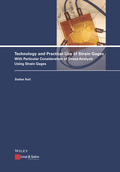Technology and Practical Use of Strain Gages
With Particular Consideration of Stress Analysis Using Strain Gages

1. Edition September 2017
512 Pages, Hardcover
14 Pictures (14 Colored Figures)
12 tables
Handbook/Reference Book
Short Description
This work is an indispensable reference work for academia and research, and a detailed instruction guide for measurement installation and implementation of strain gages as well as for interpretation of the results. Application examples and comments help avoid typical mistakes.
Buy now
Price: 169,00 €
Price incl. VAT, excl. Shipping
Euro prices for Wiley-VCH and Ernst & Sohn titles are only valid for Germany. In EU countries, local VAT applies. Postage will be charged.
This book is a profound compendium on strain gages and their application in materials science and all fields of engineering. It covers both the theoretical and practical aspects of strength and stress analysis using the technique of strain gages. A brief historical review about strain gage inventions is looking at the "who, when and how". The comprehensive bibliography leads to additional background information.
Particular consideration is given to the stress analysis in order to verify the mechanical properties and capacity of components with focus on stability and serviceability, optimization, and safety checks, as well as in order to foresee inspection and monitoring. The practice-oriented descriptions of the principles of the measurement, installation and experimental set-ups derives from the author`s own experiences in the field. Particular emphasis is laid on the correct planning and assessment of measurements, and on the interpretation of the results. Step-by-step guidance is given for many application examples, and comments help to avoid typical mistakes.
The book is an indispensable reference work for experts who need to analyze structures and have to plan measurements which lead to reliable results. The book is instructive for practitioners who must install reliable measurement circuits and judge the results. The book is also recommended for beginners to get familiar with the problems and to learn about the possibilities and the limits of the strain gage technique.
2 Fundamentals of strain gage technology
2.1 Measurement principle and structure
2.2 Sensitivity
2.3 Transverse sensitivity
2.4 Temperature effect
2.5 Mechanics of the strain gage
2.6 Influence of pressure
2.7 Dynamic behavior
2.8 Heat dissipation
2.9 Measuring at elevated temperatures
2.10 Stress gages
3 Installation of strain gages
3.1 Preparatory work
3.2 Methods of fastening
3.3 Remarks on some measurement object materials (Glas, enamel, glaced porcelain, Concrete, Wood, Plastics)
3.4 Measurement point protection
3.5 Quality tests of the strain gage installation
4 The Wheatstone bridge circuit
4.1 Circuit principle
4.2 Basic equation of the bridge circuit
4.3 Temperature compensation
4.4 Limit of the bridge signal resolution
4.5 Examples of some elementary bridge circuits
5 Adjustment and compensation circuits
5.1 General
5.2 Compensation of zero shift with temperature change and zero adjustment
5.3 Compensation of temperature effects on the sensitivity and linearization measures
5.4 Adjustment of the characteristic value
5.5 Creep compensation
5.6 Full bridge circuits connected in parallel
6 Cable between strain gage bridge circuit and measuring instrument
6.1 Basics
6.2 Ohmic resistance of the cable
6.3 Influence of cable capacitance
6.4 Full-bridge connection in four-wire technology
6.5 Six-wire circuit
6.6 Dual channel principle
6.7 Connection of half and quarter bridges
6.8 Protection against disturbing influences
7 Signal processing
7.1 Introductory viewing
7.2 Analog instrumentation amplifier
7.3 Digital amplifier concepts
7.4 Compensation method
7.5 Multi-point Measurement
8 Calibration devices for measurements with strain gages
8.1 Introduction
8.2 Measurement chain
8.3 Characteristic and sensitivity
8.4 Calibration of the entire measuring chain as a measuring device
8.5 Compensators
8.6 Transducers
8.7 Calibration measures
8.8 Calibration of measuring arrangements with self-installed strain gages
9 Determination of mechanical stresses from strains measured with strain gages
9.1 Introduction
9.2 Terms of stress and strain
9.3 Elastic deformation and stress of a tensile rod under uniaxial tensile loading
9.4 The biaxial stress state
9.5 Mohr?s Circle
9.6 Deformation circle
9.7 Types of rosettes and grid notation
9.8 Evaluation formulas for 0°/45°/90° strain-gage rosettes
9.9 Evaluation formulas for 0°/60°/120° strain-gage rosettes
10 Application examples of elastic deformation
10.1 Initial considerations
10.2 Principal directions are known
10.3 Stress analysis for unknown principal directions
10.4 Simultaneous measurement of multiple load components
10.5 Diaphragm rosettes
11 Determination of thermal stresses
11.1 Emergence of thermal stresses
11.2 Sensing the prevented thermal expansion at identical temperatures at the compensation gage and the active strain gage
11.3 Determination of the restricted thermal expansion by computational correction of the measured values with previously measured thermal outputs on dummies
11.4 Determination of the restricted thermal expansion by mathematical correction with the thermal outputs determined at the original measurement object
11.5 The ?reversible? strain gage
11.6 Separation of the mechanical strain from the thermal strain
11.7 Compensated half-bridge strain gage with compensating resistor
12 Strain gages as a means for experimental determination of residual stresses
12.1 Preliminary observation
12.2 Cutting down method
12.3 Layer removal method
12.4 Ring-core method
12.5 Hole-drilling method
13 Stress analysis using strain gages in the elasto-plastic deformation range
13.1 Introduction
13.2 Equivalent state with elastic deformation
13.3 Elasto-plastic deformation
13.4 Stress analysis
13.5 Practical Example of application
13.6 Tensorial representation of the elasto-plastic deformation
14 Strength theories
14.1 Preview
14.2 Concept of effective stress
14.3 Experimental results
14.4 Maximum stress theory
14.5 Maximum shear theory
14.6 Extended shear theory
14.7 Plastic potential theory
14.8 Distortion energy theory (shape changing theory)
14.9 Octahedral plane shear stress theory
References
Subject Index


